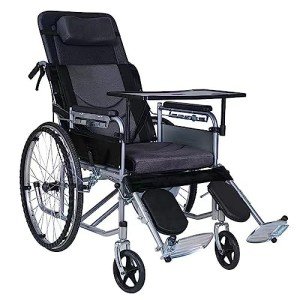Bariatric Wheelchair Seat Width
Seat Width
Having the appropriate seat width is essential to wheelchair users who spend longer durations in their chairs. Too narrow a seat will trigger pressure on the hips and thighs which might lead to sores or pressure points. Having too large a seat can likewise make it difficult for the user to reach the hand rims to move themselves or maneuver in small spaces.
To measure the proper seat width an individual would sit on a chair normally and have their measurement taken across their lap at the largest point which is typically their hips. A wheelchair measuring tape can be used to determine this, however a yard stick is chosen as it prevents people from covering the tape around their hips which would give an incorrect outcome.
The basic wheelchair seat width is 16" (narrow grownup), 18" (standard adult), and 20" (wide adult). For bariatric patients, a 24" seat is readily available. bariatric wheelchair scale from Medline features swing-away footrests, a carbon steel frame with rust- and chip-resistant chrome plating, and easy-to-clean vinyl upholstery. It has a weight capacity of 500 pounds.

Seat Depth
Traditionally, the seat depth of a bariatric wheelchair was added 2" to the measurement taken at the user's best point (normally their hips). This was meant to accommodate additional layers of clothing that may be worn during winter. However, this practice is ending up being less common as wheelchair users have the ability to invest more time inside your home and are not using long coats. This makes the seat depth of a chair lesser when selecting a bariatric wheelchair. However, it is still essential to pick an option that uses adequate assistance for larger users.
The Medline folding additional large bariatric manual wheelchair includes a comfy 24" seat width and a heavy-duty slide tube silver vein frame. It likewise has an adjustable axle and tool-free raising legrests.
Seat Height
When it comes to identifying the correct wheelchair seat width you need to constantly determine from the user's best point which is generally their hips. You will also require to consider whether the user is going to be using a winter coat as this might add 2" to the width required.
When a wheelchair remains in use it need to just be run on level surfaces with the wheel locks completely engaged. This is to prevent the chair from having the ability to move slopes that are 10 degrees or greater. It is also essential to keep in mind that any activity that may shift the center of mass in the chair should be made with care. This consists of reaching for products that require the individual to lean out of their seat or trying to stand from it.
Whenever you have the chair in use it is recommended that you routinely examine it for damage and lubricate any areas that are deemed necessary. For instance, the casters should be lubricated by removing the caster fork and utilizing a multi-purpose grease to apply to the caster stem bearings. Similarly, the foot plates can be adjusted by loosening the bolt and after that moving them to the wanted position. This allows the feet to sit easily on the footplate and avoids any pressure points from forming. This can be extremely unpleasant for the user and if left unattended, can result in press sores.
Weight Capacity
Bariatric wheelchairs are designed to support more weight than basic wheelchairs. This makes them sturdier and much better geared up to handle falls. They are also normally larger and wider, making them less maneuverable in tight spaces than standard wheelchairs. They need vehicles with unique ramps and lifts to pack them, as well as motorists who understand how to finest transport them from one area to the next.
When selecting a wheelchair, consider its weight capacity as it will be the primary determining consider whether it will accommodate your passenger's needs. The weight capacity of the chair is typically listed as a static load, meaning that it shows the quantity of weight the chair can comfortably hold while stalling. However, some producers also list an active load that is based on a drop test and can replicate the result of somebody sitting down in the chair. This may be a more dependable measurement of the weight limit, depending upon your needs.
If you prepare to perform activities that move your center of gravity in the seat (such as grabbing objects), make certain to have front casters pointed in a forward direction and wheel locks engaged so the chair will not topple. Also, examine that casters are oiled routinely to avoid excessive wear and abrasions. The lubrication procedure involves removing the fork, separating the caster from the wheel, and greasing the caster stem bearings with premium multi-purpose grease.
